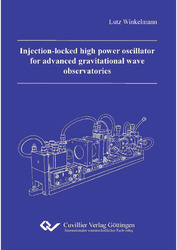| Areas | |
|---|---|
| Serie de libros (96) |
1377
|
| Nachhaltigkeit |
3
|
| Gesundheitswesen |
1
|
| Letra |
2361
|
| Ciencias Naturales |
5403
|
| Matemática | 229 |
| Informática | 318 |
| Física | 979 |
| Química | 1362 |
| Geociencias | 131 |
| Medicina humana | 243 |
| Estomatología | 10 |
| Veterinaria | 108 |
| Farmacia | 147 |
| Biología | 835 |
| Bioquímica, biología molecular, tecnología genética | 121 |
| Biofísica | 25 |
| Nutrición | 45 |
| Agricultura | 1004 |
| Silvicultura | 201 |
| Horticultura | 20 |
| Ecología y conservación de la tierra | 148 |
| Ciencias Ingeniería |
1788
|
| General |
97
|
|
Leitlinien Unfallchirurgie
5. Auflage bestellen |
|
Erweiterte Suche
Injection-locked high power oscillator for advanced gravitational wave observatories (Tienda española)
Lutz Winkelmann (Autor)Previo
Indice, Datei (43 KB)
Lectura de prueba, Datei (300 KB)
One approach to detect gravitational waves, which have been postulated by Albert Einstein in his General Theory of Relativity, is based on interferometric measurements of
length variations with a large-scale Michelson interferometer. The detection range of these
ground-based observatories is currently limited to approx. 15 Megaparsec (Mpc) because
of a reduced sensitivity at detection frequencies of 10 Hz – 10 kHz by shot noise. These
limitations can be overcome by an output power increase of the detector’s light source,
which will enhance the sensitivity by an order of magnitude. Thus, the possibility of detecting a gravitational wave will be raised by a factor of 1000 and the detection range will be increased to 150 Mpc, accordingly.
In this work a laser systems is presented, which fulfills the free-running laser requirements
on stability and beam quality required by the next generation of gravitational wave detectors for the first time. The developed laser system is based on a two-stage concept,
supplemented with an active amplitude and frequency stabilization, which is not part
of this work. A 35 W Nd:YVO4 amplifier system with an emission wavelength of 1064
nm represents the frequency reference of the laser system and is used as the seed for an
injection-locked high power oscillator. This amplifier, which is based on a Master Oscillator
Power Amplifier scheme, is already used in today’s gravitational wave detectors and has
been proven to be reliable in long-term operation. The linearly polarized output power of
more than 200 W is generated inside the oscillator stage, which consists of four Nd:YAG
crystals arranged in an asymmetric ring resonator configuration. To compensate for losses
due to thermal birefringence inside the longitudinally pumped laser crystals, an imaging
depolarization compensation is used.
To optimize the output power of the high power oscillator a numerical model was used
to calculate the resonator properties. The results derived from this model combined with
experimental data are the basis for the dimensions and mechanical design of the final
oscillator setup.
For the injection-locking of the two laser sources, the resonator length of the high power
oscillator has to be adapted and actively stabilized to be resonant with the incident seed frequency. Changes in temperature of the mechanical components result in length variations which will negatively affect the coupling of both laser systems. To compensate for this thermally induced elongation, various mechanical models have been qualitatively studied and an adequate solution consisting of a combination of adapted materials and active cooling was chosen. Furthermore, an additional slow actuator was included into the laser control, which compensates for room temperature and pressure variation induced distortions.
With the developed laser system a constant single-frequency output power of 220 W with
more than 165 W in the fundamental mode was obtained. Furthermore, it was possible to
fulfill the LIGO VIRGO Scientific Collaboration (LVC) free-running laser requirements for
their next generation of gravitational wave detectors (advanced LIGO) in cooperation with
the Max-Planck Institute for Gravitational Physics in Hannover. Thus, the installation of
the presented laser system in the world largest terrestrial gravitational wave observatories
started in spring 2011.
| ISBN-10 (Impresion) | 3954041189 |
| ISBN-13 (Impresion) | 9783954041183 |
| ISBN-13 (E-Book) | 9783736941182 |
| Formato | A5 |
| Idioma | Inglés |
| Numero de paginas | 188 |
| Laminacion de la cubierta | mate |
| Edicion | 1 Aufl. |
| Volumen | 0 |
| Lugar de publicacion | Göttingen |
| Lugar de la disertacion | Hannover |
| Fecha de publicacion | 01.06.2012 |
| Clasificacion simple | Tesis doctoral |
| Area |
Física
Ingeniería mecánica y de proceso |
| Palabras claves | Physik der kondensierten Materie (einschließlich Festkörperphysik, Optik), Astrophysik und Astronomie, LIGO, Nd:YAG, single-frequency, injection-locked, laser |








